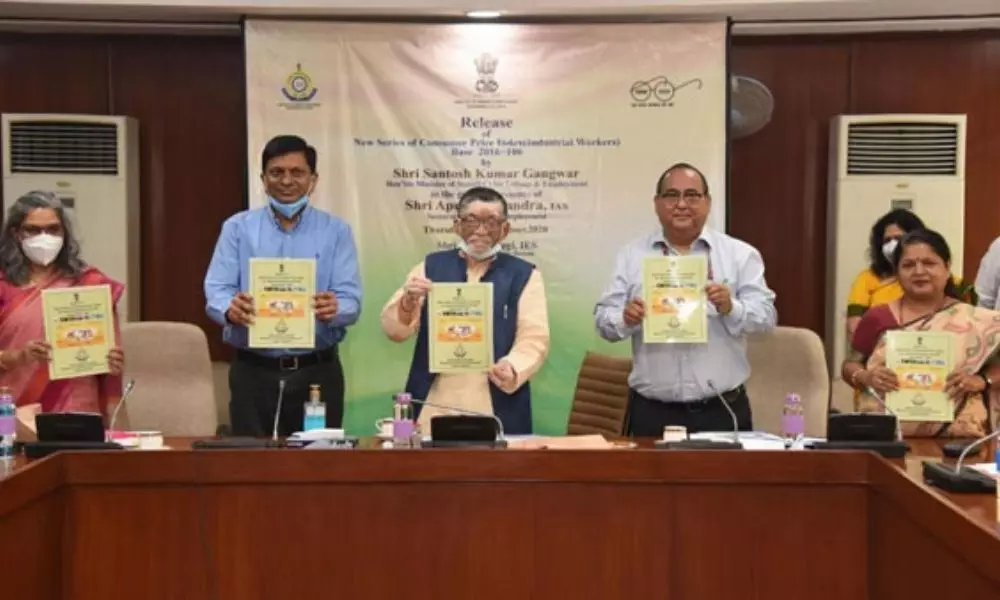Live
- Mohit Malik talks about playing a gay character
- Japan's Nippon Steel to sue US government over decision to block acquisition
- Kejriwal and Atishi will bite the dust, BJP will win all constituencies: Virendra Sachdeva
- Garena Free Fire MAX Redeem Codes for January 4, 2025: Claim Free Rewards Today!
- Heavy snow hits mountainous areas along Sea of Japan coast
- India committed to taking the lead in AI, creating opportunities for youth: PM Modi
- Arrangements in place for sarvadarshans during Vaikuntha dwara darshans
- As part of the Road Safety Month, fines should be imposed on those who do not follow traffic rules along with awareness programs District Collector Adarsh Surabhi
- Everyone should know traffic rules
- What You Need to Know About Real Estate Bank Auctions
Just In

New series of the consumer price index for industrial workers (CPI-IW) released
Labour Minister Santosh Gangwar today released the new series of the consumer price index for industrial workers (CPI-IW) with a revised base year of 2016 against 2001 in New Delhi. The Consumer Price Index-Industrial workers (CPI-IW) is the single most important price statistics with financial implications.
Labour Minister Santosh Gangwar today released the new series of the consumer price index for industrial workers (CPI-IW) with a revised base year of 2016 against 2001 in New Delhi. The Consumer Price Index-Industrial workers (CPI-IW) is the single most important price statistics with financial implications.
Mr Gangwar in a tweet today said, "Releasing of New Series of CPI-IW with 2016 Base Year. Watch Live: https://webcast.gov.in/mole/".
Releasing of New Series of CPI-IW with 2016 Base Year.
— Santosh Gangwar (@santoshgangwar) October 22, 2020
Watch Live: https://t.co/6bbL6fwvl7
"Santosh Kumar Gangwar, Minister of State (Independent Charge) for Labour & Employment, released the new series of Consumer Price Index for Industrial Worker (CPI-IW) with the base year 2016, being compiled and maintained by Labour Bureau, an attached office of Ministry of Labour & Employment," the ministry said in the statement.
The CPI-IW is used primarily for measuring Dearness Allowance payable to workers in the organized sector including Public Sector Undertakings, Banks and Insurance companies besides government employees. It is also used in the fixation and revision of minimum wages in scheduled employments besides measuring the inflation in retail prices. In future, the base revision will be done every five years, Gangwar said in a statement.
He said, earlier the base year for the CPI-IW was 2001. The Minister said, it is an important economic indicator.
Earlier, the series was revised from 1944 to 1949; 1949 to 1960; 1960 to 1982 and 1982 to 2001 since the inception of the Labour Bureau. The minister lauded the efforts of the Labour Bureau for its steadfastness and exemplary role, which have finally culminated in the release of the updated series of CPI (IW).
He mentioned that data on all aspects of labour is crucial to serve as inputs in policymaking and this justifies the existence of an organisation like the Labour Bureau, dedicated to labour and price statistics.
The report on "New Series of Consumer Price Index for Industrial Workers (Base 2016=100)" is an important publication, meant to give insights into the concepts, definitions and methodology related to the new series of CPI-IW with 2016 as the base year.
This will serve as a useful reference book for researchers, academicians, scholars and all other stakeholders of CPI-IW.
As per the recommendations of the International Labour Organisation (ILO), Index Review Committee (IRC) and National Statistical Commission (NSC), the base year of price index numbers should be revised at frequent intervals, generally not exceeding 10 years to reflect the changes that take place in the consumption pattern of consumers.
The CPI-IW is compiled as per international best practices and guidelines of the ILO.
Gangwar also released the maiden index with the base year 2016 for September 2020. The index is compiled for 88 centres. The All India index for September 2020 stood at 118, and the linking factor for the conversion of the new series index to the previous series on base 2001=100 is 2.88.
The CPI-IW (2016=100) series replaces the CPI-IW (2001=100) series.
The new series is more representative in character and reflects the latest consumption pattern of the industrial workers. In the new 2016 series, a total of 88 centres have been covered as against 78 centres in the 2001 series.
The sample size for the conduct of Working-Class Family Income and Expenditure Survey, on the basis of which weighting diagrams have been derived, was increased to 48,384 families from 41,040 in the 2001 series, Gangwar said.
The number of selected markets for collection of retail price data has also been increased to 317 under the 2016 series compared to 289 covered in the 2001 series. The number of items directly retained in the index basket has increased to 463 items over 392 items in the old series. The number of states/UTs has increased to 28 under as against 25 in the 2001 series.
In the new series, as per the direction of the Technical Advisory Committee (TAC) on Statistics of Prices and Cost of Living (SPCL), the Geometric mean based methodology (GM of Price Relatives) is used for the compilation of indices as against Arithmetic mean used in 2001 series.
The group-level weights under new series have changed in comparison to earlier series (1982 and 2001).
The weight of Food & Beverages has declined over time, whereas the weight of the miscellaneous group (Health, Education, Recreation, Transport, Communication etc) has increased substantially under the 2016 series. The weight of the Housing Group has been increasing over a period of time.
Source: PTI.

© 2024 Hyderabad Media House Limited/The Hans India. All rights reserved. Powered by hocalwire.com







